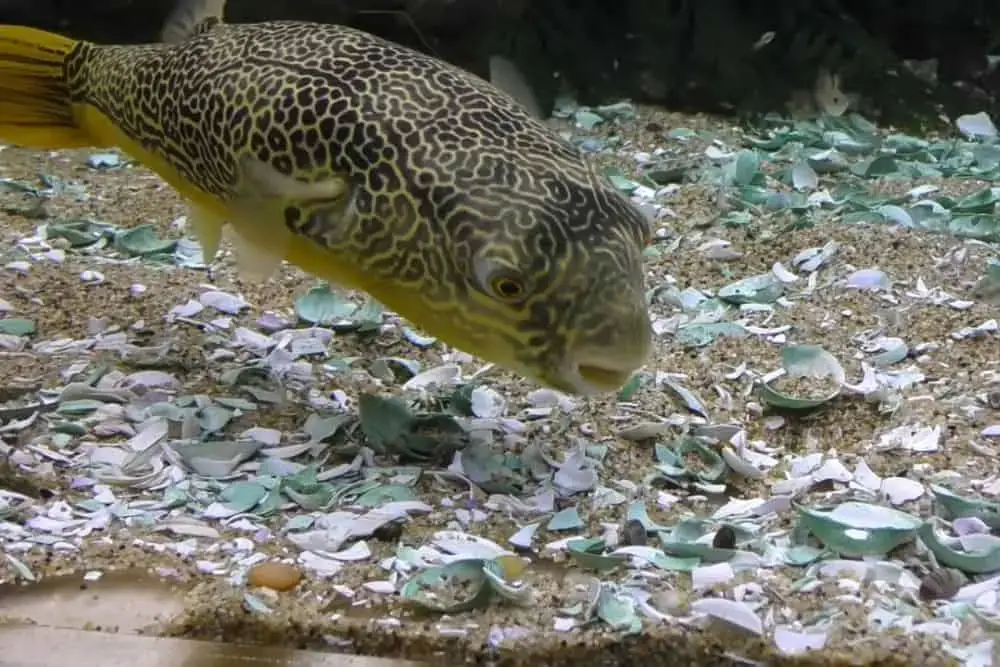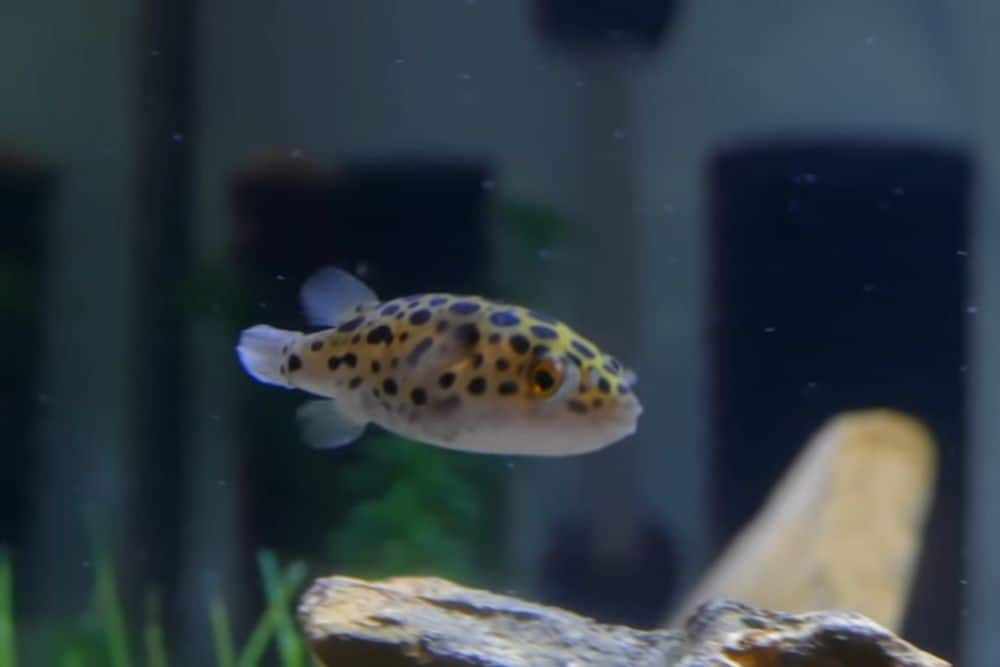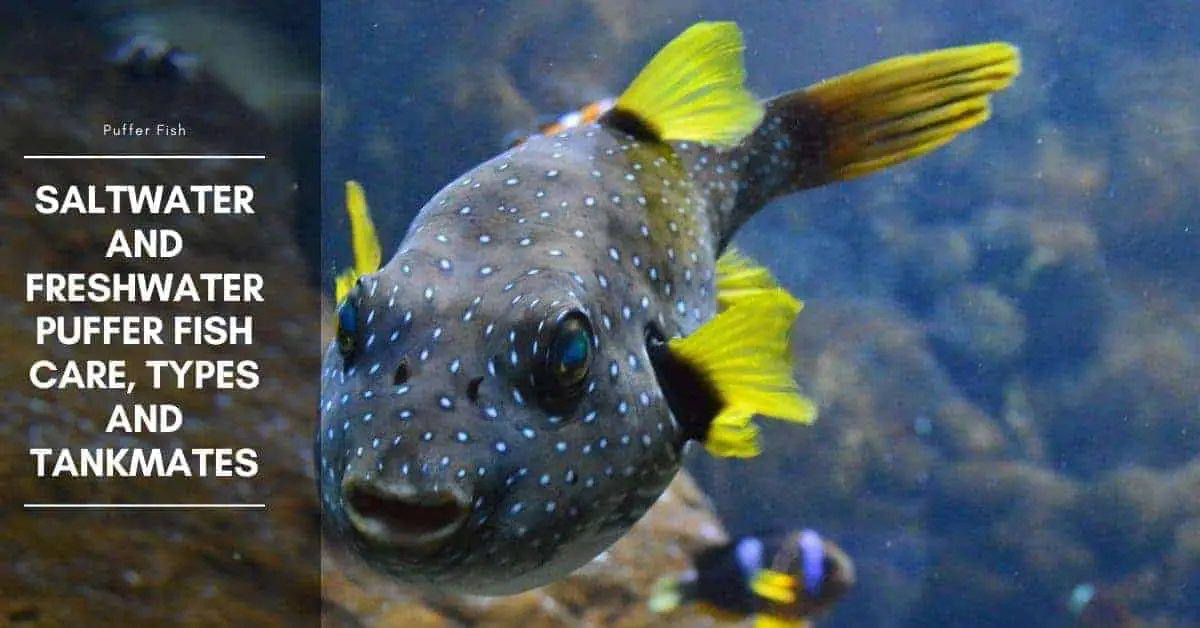Puffer fish is diverse in the tropics in every corner of the world including Asia or South America and others. Therefore, modern fishkeeping is popularly practiced with puffer fish diverse species.
Basically, to raise pufferfish requires many precautions for a beginner. Many species of puffer fish known to be a naturally highly aggressive freshwater fish can sometimes harm other smaller fish or aquatic animals to death if kept in a home aquarium. Obsessively possessive of its territory, some of them can inherit many aggressive traits and even ask for smaller prey for snacks during free time.
Puffer Fish Tank Mates
Here are the top possible Puffer fish tankmates:
- Otocinclus
- Bristlenose pleco
- Corydoras
- Amano Shrimp
- Kuhli loach
Beautifully shelled animals like prawns or clams are natural treats for puffer fish or some species of pufferfish unfamiliar can also be harmed. With their unfriendly nature, they do not treat other fellow species as friends. Therefore, any slow swimmer small fish will merely be a buffet for them. In case of a highly aggressive puffer fish, it can be raised solely although a keeper may think the fish may feel lonely this practice makes a keeper at ease( better than raising with other fish species as puffer fish will end up killing them all – a waste of money).
Or else, if the fish cannot stand being alone anymore, raise it with other pufferfish species that are less aggressive (Actually, with its sluggish movement and inflated shape, it fails to chase after others despite wanting to show its ferociousness.) A keeper is suggested to find a smaller species of pufferfish like dwarf puffer fish that can be best raised together with other species as tank mates.
How to Care Puffer Fish
To raise puffer fish, it is naturally active which requires a lot of rooms for it to move around feeding itself (much to its heart’s content.) However, some species are hidden hunters in their respective spots in a similar to a rock resulting in being able to raise in a relatively big area. Deciding to buy a home aquarium requires one to consider types of pufferfish. Besides, some puffer fish living in freshwater and probably migrating to brackish water or saltwater until adulthood is, for example, green spotted puffer.

Therefore, the salinity of water must be considered for some reaching adulthood. In the case of naturally habituating freshwater species, a keeper is not required to do anything about the salinity of the water. The increasing the salinity of water only is a method of raising some species of pufferfish.
More importantly, puffer fish is a very picky eater that hardly eat readymade fish feed to the point of starving to death without a bite. I, myself, took a walk and found some selfish fish store gave customer false information suggesting to raise pufferfish with golden fish and feed it with feed flakes. Much to my frustration, I am relieved that this kind of store went down and more and more keepers understand the nature of puffer fish.
What Do Puffer Fish Eat?
What pufferfish like to eat are fresh smaller aquatic animals such as prawns, clams or frozen worms. They can be trained to eat dead things or alive creatures making the fish caught them. If latter, just simply give the fish a shelled clam helping its teeth stronger and sharper. In fact, adult puffer fish mainly feed on shelled aquatic animals due to their front teeth continuing to grow bigger. If not for hard-to-chew food, pufferfish cannot sharp their teeth and eventually cannot eat anything at the end resulting in scrawny physique and death. Nevertheless, young puffer fish should not be given too much of hard-shelled food – only small freshwater clams are okay to help the youths gnaw at.
Tetra AquaSafe Plus, 8.45 Ounces, aquarium Water Conditioner And Dechlorinator, Model Number: 46798162681
$8.49 (as of July 13, 2024 11:01 GMT +03:00 - More infoProduct prices and availability are accurate as of the date/time indicated and are subject to change. Any price and availability information displayed on [relevant Amazon Site(s), as applicable] at the time of purchase will apply to the purchase of this product.)API TAP WATER CONDITIONER Aquarium Water Conditioner 16-Ounce Bottle
(as of July 13, 2024 06:40 GMT +03:00 - More infoProduct prices and availability are accurate as of the date/time indicated and are subject to change. Any price and availability information displayed on [relevant Amazon Site(s), as applicable] at the time of purchase will apply to the purchase of this product.)API STRESS COAT Aquarium Water Conditioner 4-Ounce Bottle (85B)
40% OffGiving them some small pieces of land animals like pork or chicken can be an alternative in case of a shortage of the first type of food. Obviously, puffer fish dislike eating land animals as aquatic animals have different enzymes unable to digest any poultry or other kinds of meat. It may result in bloating more easily than other aquatic animals. Feeding fish must be moderate. Starving them sometime can be done to avoid overeating leading to indigestion.
To care for pufferfish, food waste can be cleaned thoroughly and take into account because it is quite a gluttonous eater. If not, raw food waste can contaminate water making fish ill.
A big-sized or small-sized aquarium filter can be a solution if a keeper cannot take care of it thoroughly. Besides, changing aquarium decoration or rearranging new aquascapes must be performed to change the new environment for pufferfish definitely giving delight and recreation to a keeper.
Types of Puffer Fish
Somphong’s puffer or redeye puffer fish
“Somphong’s puffer” was first discovered by Somphong Lek-aree. It belongs to the family of Tetraodontidae. It has a greyish-green body with a white stomach having dark grey stripes from back to the side. It can adjust body-color from dark to light according to the environment condition with rotatable redeyes. Males and females can easily be differentiated as males are 3 times bigger than females and have red bodies while females have the green. Diverse in Thailand’s canals, it stays hidden water hyacinths. It can be caught easily for its slow movement. One hyacinth can contain 3-4 somphong’s puffer fish. Now it can be bred in a tank. There is a sub-species called Carinotetraodon cf. salivator found in the south of Thailand in Golok River and Ta Pi River. It is reported to widely live in Malay peninsula and the north of Kalimantan. With its unique physique from others, it has a flat body but relatively big dorsal fin and caudal fin allowing it to be a fast swimmer although it can inflate themselves smaller others. It is considered as dangerous and ferocious creatures as reported to harm people swimming around their territory.
Golden Puffer
A golden puffer is in the family Tetraocloncidac. Its unique features include 4 teeth and a flatter side body when compared with other species. It has a bright greenish golden body with a white stomach and relatively bid dorsal fin and caudal fin making it swim faster than other species. In nature, this type of puffer fish bite shrimps, snails, clams, and fish by using a jaw specially developed with a strengthened edge – can perform the task instead of teeth. Thanks to its characteristics, infant golden puffers are popularly raised to control and eliminate shells on aquatic woods because freshwater fish do eat such woods. The disadvantage is that it cannot be raised with other fish species because it is quite ferocious. Golden puffers normally gather around in a group in the tidal zone of a major river in Southeast Asia. Known to harm people, it is scared and loathed by many children and riverside people. Golden puffers Chonerhinus nefastus are commonly found in Mae Khong River and branches. At adulthood, its bodies are quite small yet visibly longer than C. modestus.
Ocellated Puffer Fish
It is a tiny pufferfish with a slightly flat side body and small fin. It has a dark or olive green body with yellow spots, or its body is full pale with dark-striped back. It has a black ring around the side body and a pair of red eyes. Having red or pink dorsal fin, it has thin skin and lacks spikes around the body making it skin beautifully shiny. Ocellated puffer fish grow to 4-5 cm. Commonly found in India, Myanmar and widespread to the northern ocean of Thailand, it inhabits the south canals and rivers by hiding in rocks and aquatic plants preying on small aquatic animals.
Hairy Puffer Fish
This species is uniquely known for its outstanding disguise and mind-blowing inflation. Its head is huge but its eyes are smaller than others. Hair-like cirri is covered from head to body becoming the source of its name. It has a reddish-brown or dark khaki body with pale spots and dark-spotted yellowish-brown fin. Its habitat is a rocky water area having crannies. In Mae Khong River, a hairy pufferfish is popular among ornamental fishkeepers although it is a ferocious aquatic animal.
Pao suvattii or Arrowhead Puffer
This type of pufferfish has an upwardly bent, long, arrow-liked mouth in between a pair of eyes. An arrowhead puffer may have an orange or red body. Once raised, it can turn into a normal color. Its common habitat is in Mae Khong River. It is not as aggressive as others in an aquarium. If the raising area contains sand or tiny gravels, this type of pufferfish will disguise into the sand leaving only eyes and lower lips, like a polyp, visible.
Redeye Puffer Fish
It is a pufferfish widespread in Southeast Asia having a relatively short beak. Its dorsal fin and caudal fin are visibly red-spotted. It can be found in rivers, canals, ponds, dams in Thailand and neighboring countries. The scientific term for the species is Tetraodon leiurus sharing similar homophones to other terms – T. cochinchinensis, T. cambodgiensis, T. fangi, etc.
Rayed-abdomen Puffer Fish
It’s commercially known as dragon puffer is found in the south of Thailand around Song Khla Lake and vicinity. It is populated seasonably in canals around Pa Pru to Daeng, Narathiwat Province. This type of puffer fish has thick skin, huge spikes, and large eyes. It inflates to football size. It is quite a peaceful pufferfish.
Green-spotted Puffer Fish

It is commonly found in a mangrove area in southeast Asian countries. With its excellent adaption, it can live in freshwater and saltwater tank( only when it grows enough, increasing salinity must be considered). Its body is 6-15 cm long and feeds on aquatic insects, larvas, clams, and small shrimps like brine shrimp.
Eyespot Puffer Fish or Figure-8 Puffer Fish
Commonly found in the east of Thailand especially Bang Pakong River and its vicinity, many of them inhabit freshwater more than green-spotted puffer fish. Its lower back has uniquely resembled 8.
Mbu Puffer Fish
It shares similar shapes with other species in the family but its body is long and flat, and the size of the body is much larger than others. It has huge eyes and more enormous caudal fin as compared to others. When it is a baby, it is covered in black spots with a green body and a yellow abdomen. Once growing up, black spots turn into web-like narrow bands all over the upper body. It is not as aggressive as others. Thanks to its large size, colorful body, peaceful habit, it is popular for fishkeeping.
Fahaka Puffer Fish
It is a type of freshwater pufferfish. Its scientific term is Tetraodon lineatus in a family of four-teeth puffer fish (Tetraodontidae). It has around the long body. Its body is yellowish-green having brown stripe on the sides that can be changed depending on its moods and environment. It grows to 30 cm in adulthood becoming the second-largest freshwater puffer fish where T.Mbu pufferfish is the largest of the same family. Its habitat is Nile River in the north and the east of the Africa continent. Unlike Mbu pufferfish, it is much more ferocious as aging making an adult fahaka puffer fish is highly dangerous when compared as once it was a baby. Therefore, for the purpose of ornament fishkeeping, fahaka pufferfish cannot be raised with others unless area is large for other species to escape. Even the same species are hunted down.
Dwarf Yellow Puffer Fish
Dwarf yellow puffer or pygmy puffer is endemic to Southwest India. They are slightly specialized in regards to what tank mates to keep them with and diet Females and juveniles of these puffers are impossible to tell apart, they are golden with brown blotches which act as camouflage in their natural environment. As they mature they can develop into male or stay female, only 1 male will develop in a group and if two develop at the same time, one will become dominant. Males tend to have “eye wrinkle” patterns and a dark stripe down the center of the belly so they can be told apart. Females also tend to be slightly larger and more rounded than males. These are the smallest known puffer species, reaching around 1 inch in size when fully grown.
In Summary
A puffer fish is considered to be another species full of charms thanks to unique physique and behaviors. Many fishkeepers cannot help but be impressed by its features. Despite strong-looking build, it requires attention in many aspects ranging from the feed, water quality, and the environment in order to raise. Once we know how to take good care of them, it is a guarantee of the perfectly intriguing charm of puffer fish as the result.

Hi, my name is Sean, and I’m the primary writer on the site. I’m blogging mostly about freshwater and saltwater aquariums, fish, invertebrates, and plants. I’m experienced in the fishkeeping hobby for many years. Over the years I have kept many tanks, and have recently begun getting more serious in wanting to become a professional aquarist. All my knowledge comes from experience and reading forums and a lot of informative sites. In pursuit of becoming a professional, I also want to inspire as many people as I can to pick up this hobby and keep the public interest growing.
Read more about Sean.
Please join also my Facebook group.



















